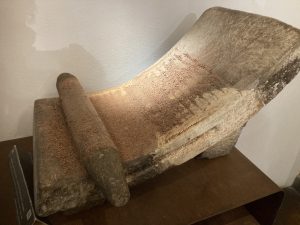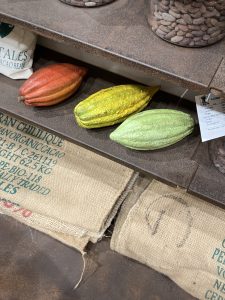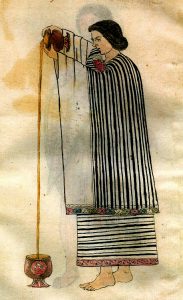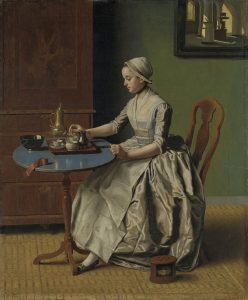In which I take a side trip in time and space to consider the Mayans, the Aztecs and Chocolate
During our visit to Antica Dolceria Bonajuta, the artisanal chocolate producer in Modica, our guide emphasized the fact that most modern chocolatiers, who use heat based methods such as conching and tempering to create smooth chocolate with a shiny appearance. By contrast, the Bonajuta chocolate makers still used a traditional “cold-processing” method similar to that used in Mesoamerica. in which cacao beans were roasted on a metate ( a rock grinding stone) that was heated over charcoal and then pounded into a paste.
Cacao beans, and the cold-processing method arrived in Modica during the period of Spanish rule, which began soon after Spaniards invaded the Aztec empire and discovered chocolate, not only the cacao bean itself, but the highly flavored beverage served in the court of the Aztec emperors.
The cacao tree is native to Central America. It only grows in tropical areas with a temperature above 60 degrees Fahrenheit and year round moisture. In its raw state the cacao bean grows in pods on the trees known botanically as “theobroma cacao,”from the Greek word for “food of the gods” and the Mayan word for the bean itself.
The Mayans* domesticated the cacao tree and grew it both in home gardens and in large commercial plantations. They venerated the beans as a gift of the gods, using them in religious ceremonies and for healing. Pots full of chocolate drink were included in the burial goods of important people. They also traded the beans throughout Central and South America as a valuable commodity. In fact, they had a god named Ykchaua who was the patron of cacao merchants. They roasted the beans and used them to make spicy, bittersweet drinks, gruels, and porridges that they flavored in a variety of ways.
By the time of the Aztec empire,** the cacao plant was so highly valued that the beans were used as currency. One hundred cacao beans was one day’s wages for a porter. The same amount could buy a slave or a hare. Three beans would buy an egg or an avocado. One bean would buy a tomato.. The beans were valuable enough that people would make counterfeit beans or mix them with less valuable material.
One reason the beans were so valuable is that the Aztecs could not grow the tropical cacao tree in the temperate highlands near their capital. Cacao beans became the object of both trade and war. When the Aztecs conquered tropical lowland areas of the Gulf Coast from Vera Cruz to the Yucatan, tribute was often paid in cacao beans. In the reign of Ahuitzotl (1486-1502), the Aztecs conquered the province of Xoconochco specifically because it was famous for the production of high quality cacao. One of the most important areas of cacao production, the Chontalpa of Tabasco, never became part of the Aztec empire. The only way the Aztecs could get cacao beans grown in the huge Chontalpan cacao plantations was by traveling to the Chontalpan trading city of Xicallanco, which drew long distance traders from all over Mesoamerica.
The importance of cacao and other luxury products in Aztec society can be measured by the status of the long distance traders, called pochtecas. Aztec society was very stratified and the pochtecas enjoyed a high rank. There were twelve pochteca guilds in the empire, each with its own headquarters and warehouses. Membership was hereditary. The pochtecas were described and treated as warriors because their work was so dangerous. They often traveled through hostile territory to reach the markets where they purchased luxury goods for the royal house and the nobility. In addition to cacao, they traded for beautiful feathers, jaguar skins and amber.
In addition to rules about who could be a long distance trader, Aztec society had heavy restrictions on who could use or consume the luxury products that the pochteca brought back. One of the luxury goods governed by these sumptuary laws was “xocolatl” (pronounced “shoco-latle”) or “bitter water”, a cold beverage made from cacao beans that had been ground into a paste and flavored with chilies, herbs, or honey. (The Mayans, by contrast, preferred their cacao hot.) Only the royal family, nobility, warriors and long distance traders were allowed to drink it. A Spanish chronicler named Bernal Diaz del Castillo recorded that more than 2000 containers of chocolate with foam were drunk every day by Montezuma’s guard alone. The other high ranking people in Aztec society, the priests, are not included in the lists of chocolate drinkers, possibly because the priesthood were expected to live in strict austerity.
The only commoners who ever had a chance to taste chocolate were soldiers on the march. Ground cacao made into wafers was issued to every soldier on campaign as part of the military rations, along with toasted maize, maize flour, toasted tortillas, ground beans and bunches of dried chilies.
The sixteenth century Franciscan missionary, Fray Bernardino de Sahagún, listed nine different chocolate drinks served to the emperor in his twelve volume book on the Aztecs, A General History of New Spain. They included “green cacao-pods, honeyed chocolate, flowered chocolate, flavored with green vanilla, bright red chocolate, huitztecolli-flower chocolate, flower-colored chocolate, black chocolate, white chocolate”. In addition to vanilla, honey and cinnamon, the drinks were flavored with spices such as hot chilies, anise, achiote, and allspice. It was poured from container to container to produce stiff foam that was an important element of the drink. It was served at the end of a meal, like a dessert.
The Spaniards brought back cacao beans alongside other treasures, but the bitter beverage was slow to catch on in Europe until the Spanish added sugar—which arrived in Europe from Southeast Asia at much the same time.*** Once it was sweet, chocolate became a popular luxury item in Europe.
*Just to give you a sense of the timeline, because even chocolate needs context: The classic Mayan civilization flourished from around 250 to 900 CE. In the ninth century, the Mayan culture suffered from a major political collapse, in which cities were abandoned. A reduced version of the culture, marked by independent provinces that shared a common culture, survived to the eve of the Spanish conquest. The final independent Mayan city fell to the Spanish in 1697.
**The Mexica, as the Aztecs called themselves, are believed to have been a nomadic people who migrated into central Mexico in the thirteenth century and founded the city-state of Tenochtitlan in 1325 CE. In 1428, the Mexica allied with two other city-states, forming the Aztec Triple Alliance and the beginnings of what we know as the Aztec Empire. The Spanish, led by Hernando Cortez, arrived in 1519. Two years later, after a bitter siege, the Aztecs surrendered and Cortez began to build a new city on the ruins of Tenochtitlan.
***The relationship between imperialism and food is long and complicated.








